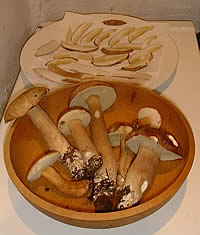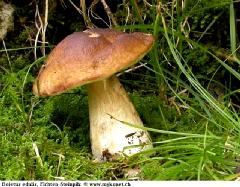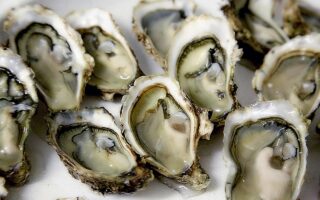Eating Wild French Mushrooms? Take Care!

A warning about eating wild French mushrooms: this is a true account about poisonous wild mushrooms in France.
Whenever I mention “the mushroom poisoning” to a local, they respond by saying “I heard”. There’s usually a touch of irony playing about their eyes.
It all started with our enthusiasm for the popular French pastime of picking and eating wild mushrooms. Being a fan of foraging, I was dying to experience the joy of collecting a mushroom bounty. In addition, unexpected hardship one autumn meant that we particularly loved the idea of some free and tasty protein in our diets.
After several mushroom missions, we kept ending up with a bizarre selection of single specimens. We had trouble identifying them from our small book on the subject. The pharmacy told us to chuck anything that wasn’t an obvious cépe, and all the ones that I took to a neighbour turned out to be poisonous or dubious. What a disappointment.
Undeterred, the missions continued. Finally we found a couple of sources of good old field mushrooms, which we checked for the signs of the poisonous Yellow Stainer. Certain that they were safe, we were very pleased with ourselves, relieved that we were at least able to find some mushrooms to eat. They were tasty, and they gave us confidence in our search for more elusive mushrooms.
In fact, we talked about it at a dinner party, where people were concerned for us and the risks they felt we were taking; we joked “It’s certainly exciting!”. Oh dear. We had seen lots of terrifying-looking examples of the boletus family (the same family as ceps). They tended to be massive, with lots of red, blue and green colouring. How satisfying it would be, we thought, to find an edible mushroom that big.
Having read about the poisonous effects of Satan’s Boletus, we were not prepared to risk any of them with any red coloration, but due to frustration, the morning after the dinner party, we took various other boletus home for identification. Most were rejected simply because we could not identify them, but one looked less harmful, so we did a bit of research on it before lunch.
 The facts, as we knew them: The only boletus that is actually poisonous is Satan’s Boletus. The rest were supposed to be delicious or at least digestible. We checked books and the internet, but our harmless-looking specimen had none of the traits to be wary of, and it smelled good. So I cooked it up for lunch with garlic, parsley, crème fraîche and a dash of whisky. Strangely, though, it tasted a bit bitter.
The facts, as we knew them: The only boletus that is actually poisonous is Satan’s Boletus. The rest were supposed to be delicious or at least digestible. We checked books and the internet, but our harmless-looking specimen had none of the traits to be wary of, and it smelled good. So I cooked it up for lunch with garlic, parsley, crème fraîche and a dash of whisky. Strangely, though, it tasted a bit bitter.
I had a few mouthfuls and then decided not to risk any more. I wasn’t enjoying it anyway. Perry soldiered on and finished his portion, despite being particularly sensitive to bitter flavours. Against my protests, he did not want to reject food that I had prepared for him.
We both went back to work, after saying that in future we would always ask a neighbour or the pharmacy before trying a mushroom. I was slightly uneasy and slightly nauseous all afternoon, but Perry was fine, and I thought I was just being paranoid.
After he finished work, Perry went out to mow the lawn, but after a couple of minutes he came back inside, saying that he suddenly felt ill. He looked scared, and told me that he knew it was the mushrooms. Five minutes later, he was curled up on the gravel, sweating, shivering, retching and spasming. This is is the part that I remember like a nightmare, because I was so scared and shaky that it all seemed surreal.
Finally, the doctor arrived, and I watched with tears in my eyes. The doctor asked what time we had eaten the mushroom. Perry started being ill precisely four hours after our lunch, which the doctor explained was the exact time delay for Satan’s Boletus. Thankfully, it would not be fatal, but Perry needed to get to hospital. It was at this point that I suddenly had to run outside and was sick.
There was no way I could drive, so I rang my friend, Anna, an ex-nurse, to take us to the hospital. After a night on a drip, and lots of medication, we were physically restored. The doctors told us that mushrooms vary regionally, and that we had eaten a local version of Satan’s Boletus. This is why you should always ask a local expert before eating a mushroom. Feeling very stupid, we were slightly comforted by the doctor telling us that a French man had made the same mistake a week earlier.
Since then, I have been haunted by the thought of deadly mushrooms, like the Death Cap, which has a massive delay before you start to feel ill and know what you have done, but there is absolutely nothing that can be done to save you.
The experience hasn’t put me off mushroom collecting. We’ve actually had quite a lot of success, and can now easily recognise several different kinds of mushroom with certainty. But we always get a local expert to verify our finds.
After all, there’s no room for error.
Share to: Facebook Twitter LinkedIn Email
More in beach, cooking, family, food, people, technology, work
By Gemma Driver
Leave a reply
Your email address will not be published. Required fields are marked *



